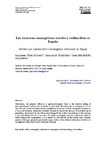Mostrar o rexistro simple do ítem
Los elementos cosmogénicos estables y radioactivos en España
| dc.contributor.author | Vidal Romaní, Juan Ramón | |
| dc.contributor.author | Arce-Chamorro, Carlos | |
| dc.contributor.author | Fernández Mosquera, Daniel | |
| dc.date.accessioned | 2023-03-06T16:06:50Z | |
| dc.date.available | 2023-03-06T16:06:50Z | |
| dc.date.issued | 2022-12-28 | |
| dc.identifier.citation | Vidal Romaní, J. R., Arce-Chamorro, C., Fernández Mosquera, D. (2022). Los elementos cosmogénicos estables y radioactivos en EspañaCadernos do Laboratorio Xeolóxico de Laxe. Revista de Xeoloxía Galega e do Hercínico Peninsular, 44, 33-54. https:// doi:10.17979/cadlaxe.2022.44.0.9405 | es_ES |
| dc.identifier.issn | 2173-6936 | |
| dc.identifier.issn | 0213-4497 | |
| dc.identifier.uri | http://hdl.handle.net/2183/32627 | |
| dc.description.abstract | [Abstract] Historically, the greatest difficulty in geomorphology work has been the absolute dating of geomorphological surfaces, which reaches its maximum when the surface lacks any type of coating. It is then that the only criterion is either the creative imagination or the use of stable cosmogenic isotopes and, failing that, of radioactive ones, since as long as the stability of a surface can be guaranteed, the method will give an absolute age for the surface. Dating has different precision depending on which isotope is used. In the case of stable cosmogenics there is no age limitation, although in others (radioactive cosmogenics) it would be limited by the half-life of the isotope used. The detailed analysis of the geological and geomorphological history of the analyzed surface should never be neglected, more than in any other type of dating. | es_ES |
| dc.description.abstract | [Resumen] Desde siempre la mayor dificultad en los trabajos de geomorfología ha sido la datación absoluta de superficies geomorfológicas que llegan al máximo cuando la superficie carece de cualquier tipo de recubrimiento. Es entonesc cuando el único criterio es, o la imaginación creativa o el uso de los isótopos cosmogénicos estables y en su defecto de los radioactivos ya que siempre que se pueda garantizar la estabilidad de una superficie el método dará una edad absoluta para la superficie. La datación tiene una precisión diferente según cual sea el isótopo utilizado. Para el caso de los cosmogénicos estables no hay limitación de edad aunque en otros (cosmogénicos radioactivos) estaría limitada por la vida media del isótopo utilizado. No debe nunca desdeñarse, mas que en cualquier otro tipo de datación, el análisis detallado de la historia geológica y geomorfológica de la superficie analizada. | es_ES |
| dc.language.iso | spa | es_ES |
| dc.publisher | Universidade da Coruña, Servizo de Publicacións | es_ES |
| dc.relation.uri | https://doi.org/10.17979/cadlaxe.2022.44.0.9405 | es_ES |
| dc.rights | Atribución-CompartirIgual 4.0 Internacional (CC BY-SA 4.0) | es_ES |
| dc.rights.uri | https://creativecommons.org/licenses/by-sa/4.0 | |
| dc.subject | Stable cosmogenic | es_ES |
| dc.subject | Radioactive cosmogenic | es_ES |
| dc.subject | Absolute dating | es_ES |
| dc.subject | Rock surface | es_ES |
| dc.subject | Datación absoluta | es_ES |
| dc.subject | Cosmogénicos estables | es_ES |
| dc.subject | Cosmogénicos radioactivos | es_ES |
| dc.subject | Erosión | es_ES |
| dc.subject | Superficie rocosa | es_ES |
| dc.title | Los elementos cosmogénicos estables y radioactivos en España | es_ES |
| dc.title.alternative | Stable and radioactive cosmogenic elements in Spain | es_ES |
| dc.type | info:eu-repo/semantics/article | es_ES |
| dc.rights.access | info:eu-repo/semantics/openAccess | es_ES |
| dc.date.updated | 2023-03-01T19:57:35Z | |
| UDC.journalTitle | Cadernos do Laboratorio Xeolóxico de Laxe. Revista de Xeoloxía Galega e do Hercínico Peninsular | es_ES |
| UDC.volume | Vol. 44 (2022) | es_ES |
| UDC.startPage | 33 | es_ES |
| UDC.endPage | 54 | es_ES |
| dc.identifier.doi | 10.17979/cadlaxe.2022.44.0.9405 |






